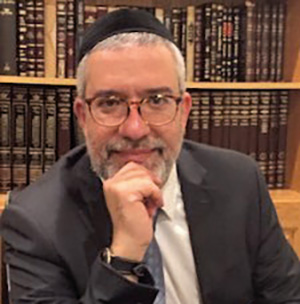
One of the stories that my father, z”l, used to tell me about his father, my grandfather, Rabbi Eyad Acoca, z”l, was that back in Morocco, at a young age, my grandfather traveled to the city of Sale to learn under the revered Hacham, Rabbi Rafael Enkaua, z”l. In order to get there, he had to cross the Bou Regreg river. Once, while my grandfather was on a raft with other travelers, the raft tipped and all the people drowned except my grandfather, who held tightly onto his Talmud volume and got to the other side of the river safe and sound!
My father often recounted that my grandfather’s last wish was that at least one of his descendants continue his legacy and become a rabbi. His wish was fulfilled when I became a rabbi; in doing so, I merited to inherit a few volumes of my grandfather’s set of Talmud.
Through the years, I have come to understand that I have a big responsibility to continue in my grandfather’s footsteps and teach about Sephardi Judaism, which is unique and special.
In recent years, numerous articles and lectures have been given regarding the future of Sephardi Judaism. As a Sephardi rabbi, I was delighted to see this occurrence. However, to my dismay, I have found that most of the lectures and articles have been framed in the extreme right or left. In my opinion, Sephardi Judaism has to come back to its origin, which was always the middle path.
Our great sage Maimonides teaches us in his book “Mishneh Torah” (De’ot, the laws of personal development, chapter 1, law 4):
“Each and every man possesses many character traits. Each trait is very different and distant from the others.
“One type of man is wrathful; he is constantly angry. [In contrast,] there is the calm individual who is never moved to anger, or, if at all, he will be slightly angry, [perhaps once] during a period of several years.
“There is the prideful man and the one who is exceptionally humble. There is the man ruled by his appetites—he will never be satisfied from pursuing his desires, and [conversely,] the very pure of heart, who does not desire even the little that the body needs.
“There is the greedy man, who cannot be satisfied with all the money in the world, as [Ecclesiastes 5:9] states: ‘A lover of money never has his fill of money.’ [In contrast,] there is the man who puts a check on himself; he is satisfied with even a little, which is not enough for his needs, and he does not bother to pursue and attain what he lacks.
“There is [the miser,] who torments himself with hunger, gathering [his possessions] close to himself. Whenever he spends a penny of his own, he does so with great pain. [Conversely,] there is [the spendthrift,] who consciously wastes his entire fortune.
“All other traits follow the same pattern [of contrast]. For example: the overly elated and the depressed; the stingy and the freehanded; the cruel and the softhearted; the coward and the rash, and the like.” (Chabad.org)
Maimonides writes, “The two extremes of each quality are not the proper and worthy path for one to follow or train himself in. And, if a person finds his nature inclining towards one of them or if he has already accustomed himself in one of them, he must bring himself back to the good and upright path.”
He continues, “The upright path is the middle path of all the qualities known to man. This is the path which is equally distant from the two extremes, not being too close to either side. Therefore, the sages instructed that a person measure … his character traits, directing them in the middle path so he will be whole.” (Torah.org)
How I wish that the great minds of Sephardi Jewry would sit, united, and craft the future of Sephardi Jewry through Maimonides’ model. I hope that this will happen soon but, for now, let us all implement the lesson of Maimonides and implement the middle path in all our endeavours.
As we are entering the holiday of Pesach, which represents the idea of rejuvenation, let us all think about what we are doing to keep our illustrious past as authentic as we can and follow the middle path as our ancestors did for thousands of years.
Wishing you a Chag Pesach Sameach Vekasher!
By Rabbi Ilan Acoca
Rabbi Ilan Acoca is the rabbi of Congregation Bet Yosef, the Sephardic Congregation of Fort Lee, and rav beit hasefer at Ben Porat Yosef.










